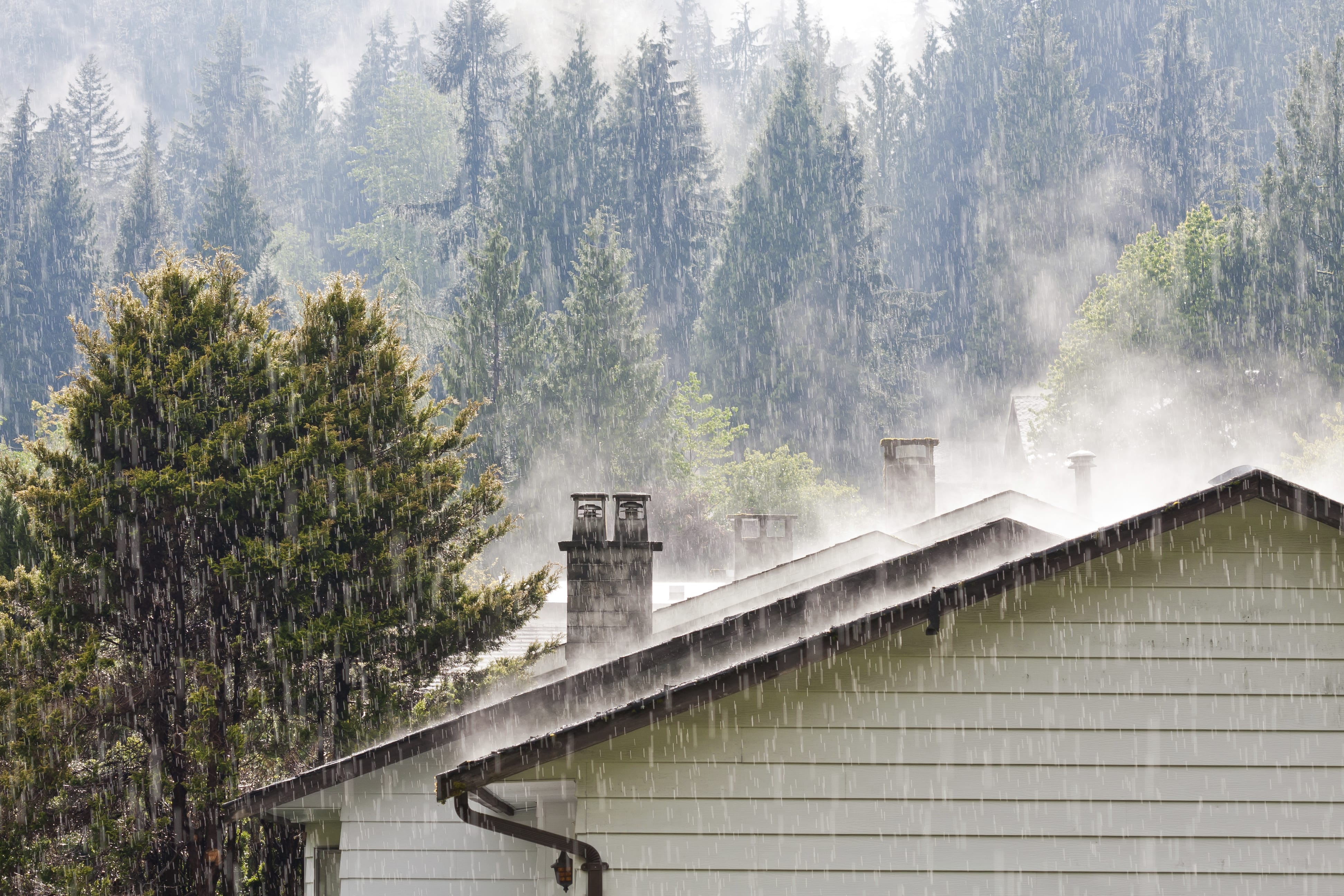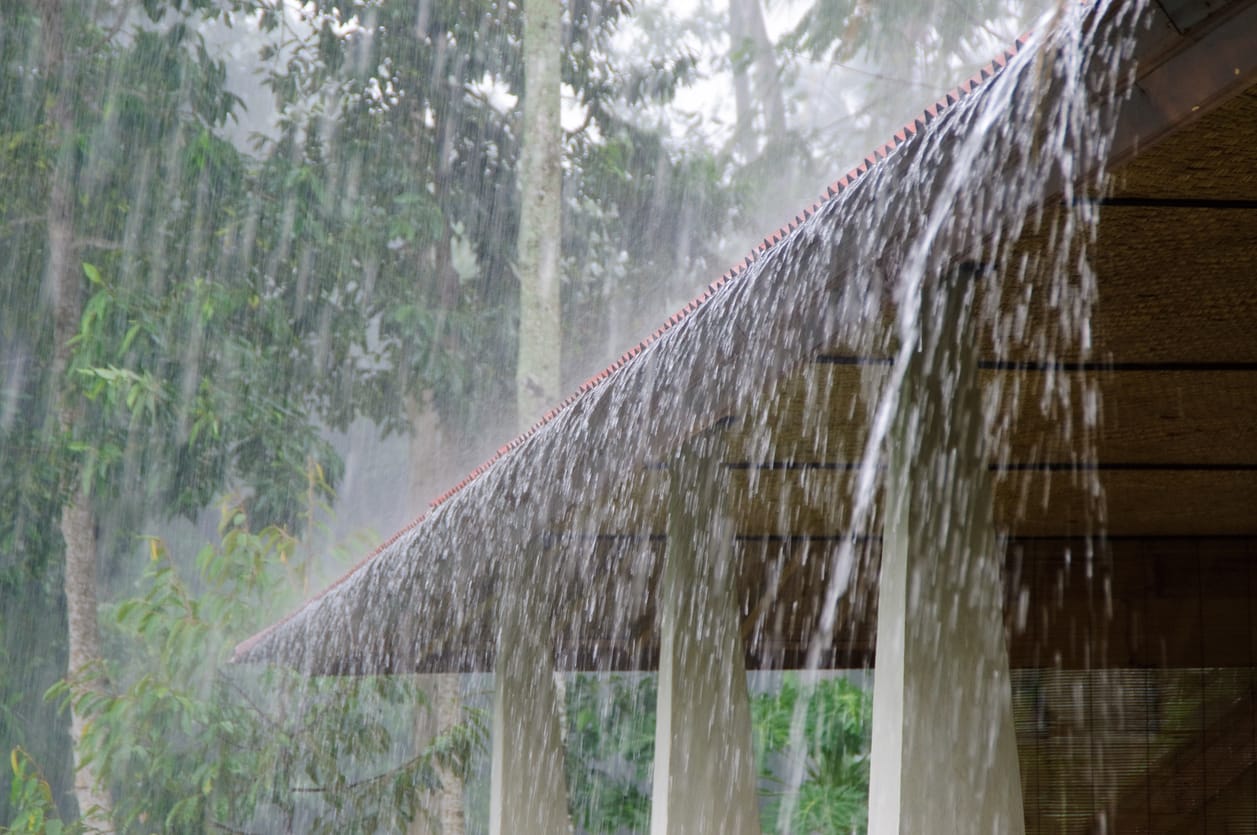How to Avoid Roof Leaks In Heavy Rain
Discovering roof leaks in heavy rain or during a storm is often a nightmare.
They can be sneaky and show up in any number of spots around your home – it’s not always the stereotypical drip from the ceiling.

With the heavy rains we’ve experienced already this year, you may have been eyeing your roof and ceilings with trepidation. Stormy seasons will show you what is good and bad about your roofing situation – and if it’s the latter, it’s at the worst possible time.
Can You Avoid Roof Leaks In Heavy Rain and Wind?
Absolutely.
Protecting your roof is imperative during storms or heavy rain. However, there are steps that must be taken before the storm hits.
So, let’s work on avoiding this problem.
There are plenty of ways to assess and prepare for any existing roof damage that can lead to a big problem down the road. We’ll cover what to look for, and how to figure out if and where the problem exists.
Preventive maintenance is the way to keep the rain out. If you’re ready to head up on the roof, here are some of the common problem areas that lead to roof leaks in heavy rain.
Problem Area 1: Around roof vents
There are two kinds of vents that can allow leaks to enter. They’re installed differently, and will require different treatment.
The first type is a plumbing vent boot. This will look like a plastic pipe that is sticking up out of your roof, about a foot high. These are connected to the roof by a metal flashing at the base level. They will also have a rubber “boot” that extends part-way up the pipe to help seal it off.
It is common for the rubber to split and crack after several years. This can lead to failure of the seal at the main metal flashing attachment and a leak that will show up on the ceiling below. The best way to deal with this is to replace the entire unit. There have also been some improvements in the boot construction that can reduce the chances of future leaks.
The second type has different looks but the same function – to keep air circulating under the roof. Depending on your home, you may have a turbine style, a ridge vent, or a flatter vent that rises a few inches above the roof. These can all leak, whether from the rain being driven into the sides from strong winds, actual damage to the vent hood, or because of leaking around the unit.
You’ll want to check each of your vents for visible damage, loose flashing or shingles, or for areas that need to be caulked or sealed. It is also possible to add a shield around the vent to slow down the driving rain, or to completely replace a damaged unit.
Problem Area 2: Chimneys
Chimneys are a common problem area for roof leaks in heavy rain or storms.
This is because there are several points of weakness that can fail over the life of your home.
Starting at the top, you’ll want to check the chimney cover for any cracks or holes. Another area that can deteriorate is the chimney crown. Depending on the material used, you’ll want to check for cracks or breakage in the mortar, stone or brick.
Further down the chimney, check for any flashing or shingles that are loose or need to be replaced. You may have a clue about this sort of leak if there are already stains on the underside of the roof below.
Some problems with water building up during heavy rains and snows can be handled with the installation of a new “cricket” – this diverts the rain and moisture away from the chimney, so that it can drain to a better spot on the roof.
Problem Area 3: Skylights
It’s essential to consider your skylights when avoiding roof leaks in heavy rain.
These are prone to leaks as they age in place. As shingles age and move slightly, and as debris catches on the upper portion of the unit, they can allow rain in.
You may already be aware of issues, since this is a pretty obvious point of leaks during a heavy rain. The way that skylights are installed will always make them vulnerable to the degradation of their connecting pieces. It’s really just part of regular home maintenance to help keep them sealed tight.
With a visual inspection, you can also get an idea if the unit needs to be caulked or sealed, or if any shingles or flashing around the unit need to be replaced. It’s normally the attachments that need maintenance, not the actual skylights.
Problem Area 4: Gutters
Gutters get clogged with leaves and other debris. If you haven’t cleaned them recently, they’re liable to overflow during heavy rains.
The issues with gutters that fail to do their job are pretty broad-reaching. If the water does not go down the gutter spout as intended, it can overflow and run directly down walls.
With heavy, long-lasting rains, this can actually take out flower beds, damage the foundation, flood basements, and damage walls. Fortunately, this is a fairly simple fix: clean and maintain your gutters.
Problem Area 5: Roof valleys
These are the “V” shaped joins on your roof. Just like gutters, they can be subject to clogging up with tree debris and leaves. They can not drain well during heavy rains.
If there are some loose shingles or poorly placed nails from the last roofing installation, you may be looking at a source for leaks in the next storm.
During your inspection, make sure that these valleys are clean of any debris, and check for damaged shingles. It’s possible that they may need to be replaced in these areas, if they are showing signs of weathering beyond the rest of the roof.
Problem Area 6: Shingle problems
Sometimes, you have a bad shingle – or a bad section of shingles. Or sometimes the whole roof is over 15 years old and up for replacement. Because of this, you’ll want to check for problems all over the roof.
Shingles can fail in many ways. They can begin curling, they can break off, they can crack, and they can simply be worn and start losing their ability to hold out the elements. Or, they can just be missing.
All of these will point to existing or future roof leaks in heavy rain, storms, or wind. Often, if one shingle has gone bad, there will be others in that section that will need to be replaced. It’s important to determine if this is localized to one spot, or if you are looking at a problem that could extend over your whole roof.
Conclusion
Once you’ve determined where the leaks are, or could come from, you’ll want to get ahead of the problem.
It’s unusual to find just one item that needs attention on a roofing inspection.
Roof leaks in heavy rain are a common problem for many homeowners, but they are preventable.
Some simple repairs might be suitable for a homeowner, but it’s best to go ahead and consult a professional roofing company to diagnose and repair all kinds of problems from clogged gutters to flashing repairs and entire roof replacements.
Don’t wait for the next leak to start before you get help – one leak can create problems from top to bottom in a home.


